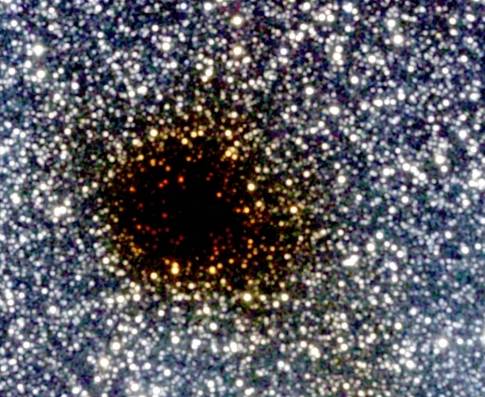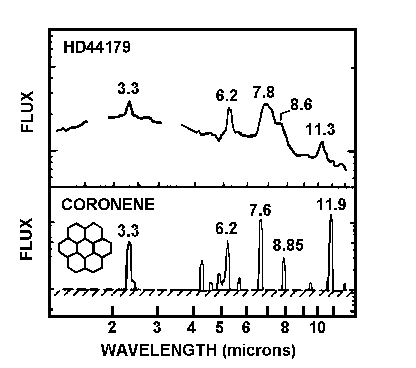1. INTERSTELLAR GAS AND DUST
|
O dark dark dark. They all go into the dark,
The vacant interstellar spaces, the vacant into the vacant ... |
|
T. S. Eliot: East Coker |
|
Four Views from The Multi-Wavelength Milky Way |
|

|
|
At optical wavelengths, the center of the Milky Way is obscured by dark dust clouds |
|

|
|
At infrared wavelengths, we see through the dust clouds to the stars at the center of the Milky Way |
|

|
|
At a wavelength of 21 cm, we see radiation from a thin layer of interstellar hydrogen gas in the Milky Way. |
|

|
|
At a wavelength of 2.6 mm, we see radiation from a very thin layer of cold, dense carbon monoxide gas in the Milky Way. These gas clouds are the star-forming regions. |
The space between the stars is not empty, but full of gas and dust. In fact, the net mass of the interstellar gas in the Milky Way galaxy is about 10 - 20% of the net mass in stars. Like the matter in the Sun and most stars, the interstellar gas is composed mostly of hydrogen (about 70% by mass), helium (about 29%), and just a trace (about 1%) of heavier elements such as carbon, nitrogen, oxygen, silicon, iron, etc. -- the stuff the Earth and your bodies are made of.
This gas has a wide range of physical conditions. Half of interstellar space is filled with
diffuse interstellar gas, having atomic density ranging from about 1 - 100 atoms/cm3. Most of the diffuse gas has temperature of about 100 K (= -280 F). We can see this gas best by observing radio emission from hydrogen atoms, which emit radio waves at the famous 21 cm line. We call such regions HI regions, the symbol HI indicating that the hydrogen atoms are neutral and not bound to other atoms. The atomic hydrogen image in the Multiwavelength Milky Way was observed through this radiation. Be sure to read the captions there. When illuminated by a nearby hot star, the interstellar hydrogen gas becomes hot (104 K) and ionized (the electrons are stripped off the atoms), and we can see optical emission lines from the gas. We call such regions HII regions.
|

|
|
An optical image of the Horsehead Nebula in Orion. The gas glows with the red spectral line of hydrogen atoms, which are ionized by the ultraviolet light from the two bright stars. The fuzzy patches in the lower center and left are due to gas illuminated by newborn stars emerging from the dark dust cloud. Source: Astronomy Picture of the Day |
A substantial fraction (20 - 60%) of interstellar space in the Milky Way is occupied by
coronal gas, which, like the solar corona, has temperatures ranging from 106 - 107 K. This gas is heated by the explosions of massive stars -- supernovae -- which we discussed in Lesson 6.
A relatively small fraction (about 1%) of the volume of the disk of the Milky Way is filled with
molecular clouds (also called dense clouds, or dark clouds), having density ranging from 103 atoms/cm3 up to 105 atoms/cm3 or greater. These molecular clouds are the places where new stars are born. We call this gas "dense interstellar gas", but it is still rarefied by Earth standards. The highest vacuum ever achieved in a laboratory on Earth has density of about 104 atoms/cm3. Most of the hydrogen gas in these clouds is in the form of H2 (molecular hydrogen, in which two hydrogen atoms are bound together chemically), in contrast to the unbound hydrogen atoms (HI) in the diffuse interstellar gas. Even though the molecular clouds occupy a relatively small fraction of the volume of interstellar space, the clouds comprise a substantial fraction (roughly 50%) of the mass of interstellar gas because they are so much denser than the diffuse interstellar gas.
In addition to H2 molecules, the molecular clouds contain many other chemical compounds, ranging from relatively simple molecules such as carbon monoxide (CO), water (H2O) and cyanide (HCN) to more complex molecules such as ethyl alcohol (CH3CH2OH). Hundreds of such molecules have been found in molecular clouds and identified by comparing their radio emission line spectra with radio spectra of the same molecules in laboratories on Earth. Since H2 molecules have no radio spectral lines, we observe the molecular clouds best through the radio emissions of other molecules. The easiest one to see is CO. In fact, the image labeled "molecular hydrogen" in the
Multiwavelength Milky Way is actually an image of radio emission from CO, not H2 molecules (which neither emit nor absorb radio waves).
By analyzing the ratios of radio spectral lines from the molecular clouds, we find that the gas there is extremely cold -- ranging from about 3 - 20K. (3K means three degrees above absolute zero: 3K = -270C = -454F).
In addition to hydrogen and helium, the interstellar gas contains
interstellar dust. The mass of dust is about 1% of the mass of the gas. The dust absorbs ultraviolet and visible light. As we have seen, interstellar dust clouds block our view of the Milky Way. If the dust clouds are not very thick, the stars are only partially obscured. Since the dust absorbs blue light more effectively than red light, the stars appear redder than they actually are. [By the same token, the setting Sun appears redder than it actually is because the sunlight is partially obscured by dust in the Earth's atmosphere.]
|

|
|
A dark dust cloud in the foreground obscures the stars of the Milky Way. The background stars on the periphery of the dust cloud are only partially obscured because the dust layer is thinner there. They appear red because the dust grains absorb blue light more effectively than red light. Source: Astronomy Picture of the Day |
Interstellar dust consists of tiny grains of silicates (much like ordinary beach sand or volcanic ash) and soot (very similar to the black soot in the exhaust of a diesel engine). We know this because we see that the infrared emission spectra from dust in interstellar space is almost identical to the laboratory spectra of tiny grains of sand and soot. For example, the first pair of graphs below is a comparison of the infrared spectrum emitted by dust in the Orion Nebula and that emitted by the exhaust of a diesel truck. Both spectra show prominent emission features at 6.2 and 7.6 micrometers that we can identify with the laboratory spectra of "Polycyclic Aromatic Hydrocarbons", or "PAHs" -- known carcinogens. The second pair of graphs is a comparison of the infrared spectrum from dust in the atmosphere of a red giant star with the laboratory spectrum of coronene, one such PAH. Observations with infrared spectrometers also show that the dust grains in the dense molecular clouds are often covered with ices, such as H2O and CO2 (dry ice).
|

|
 |
|
Upper: infrared spectrum of soot from exhaust of diesel truck. Lower: infrared spectrum from Orion Nebula. |
Upper: infrared spectrum of red giant star HD44179. Lower: laboratory infrared spectrum of coronene molecule and structure of molecule. |
What is the source of interstellar dust?
We believe that the interstellar dust is produced in the outer atmospheres of red giant stars and expelled into interstellar space by these stars during the later stages of their evolution. We see in the figure above that the infrared spectrum of the red giant star HD44179 has emission features at 6.2 and 7.8 microns, just as does the spectrum of interstellar dust from the Orion Bar.
The interstellar dust grains are very effective absorbers of optical and ultraviolet radiation, so we can't see through the dense interstellar clouds in these wavelength bands. The obscuration due to dust accounts for the dark regions we see in the optical image in the
Multiwavelength Milky Way. But we can see right through the dark clouds at infrared (and radio, X-ray, and gamma ray) wavelengths, so these dark clouds are not evident in the images in these bands.
Here is a summary of the main components of the interstellar medium, their properties, and how they are typically observed:
|
Constituent of interstellar space |
Where found |
Temperature (K)
Density (atoms/cm3) |
How best observed |
|
Atomic Hydrogen
(HI) |
Everywhere (~50% of mass, ~50% of volume) |
100 - 104 K
1 - 100 cm-3 |
21-cm radio line
Ultraviolet absorption lines |
|
Molecular Hydrogen (H2) |
Dark clouds (~50% of mass, ~1% of volume) |
5 - 100 K
104 - 100 cm-3 |
Ultraviolet absorption lines
Infrared emission lines |
|
Other Molecules (e.g., CO, HCN, H2O, etc.) |
Dark Clouds |
5 - 100 K
106 - 100 cm-3 |
Radio and infrared emission lines |
|
Ionized Hydrogen
(HII) |
Near hot stars
(Emission nebulae) |
5000 K
102 - 104 cm-3 |
Optical and infrared emission lines; radio continuum |
|
Coronal Gas |
Everywhere (~50% of volume) |
106 - 107 K
10-2 cm-3 |
X-ray emission |
|
Dust grains |
Everywhere |
20 - 100 K |
Reddening and absorption of starlight; Infrared emission |
|
Magnetic Fields |
Everywhere |
|
Polarization of starlight; Zeeman effect |
|
Cosmic Rays |
Everywhere |
|
Radio emission, gamma ray emission |
Note that there is an inverse correlation between density and temperature. The regions with greater temperatures tend to have lower densities, and conversely. That is so because hot gas tends to expand until its pressure is comparable to the cold gas. Since pressure is proportional to density times temperature, when the temperature increases, the density tends to decrease so that the pressure will remain constant.
(Return to course home page)
Last modified March 18, 2001
Copyright by Richard McCray

